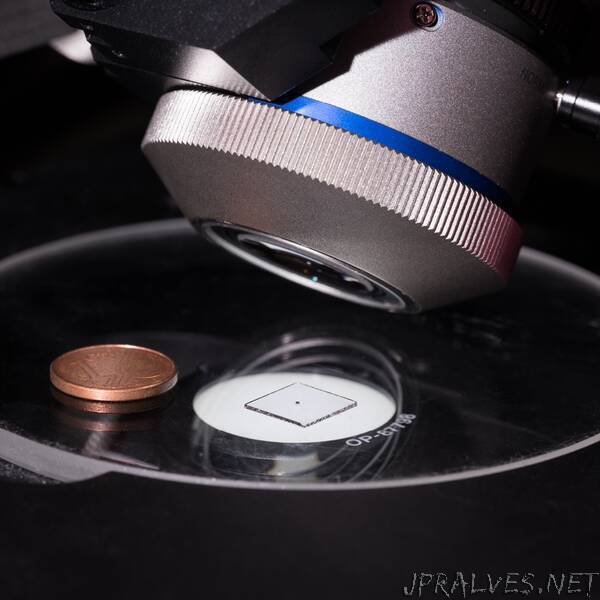
“New low-temperature coating technique poised to enable high-quality 3D printed microlens systems for applications from endoscopes to virtual reality
Researchers have developed a new way to apply antireflective (AR) coatings to 3D printed multi-lens systems as small as 600 microns in diameter. Because these coatings help minimize light losses due to reflection, they are critical for making high-quality 3D printed systems consisting of multiple microlenses.
“Our new method will benefit any 3D printed complex optical system that uses multiple lenses,” said research team leader Harald Giessen from the University of Stuttgart in Germany. “However, it is especially useful for applications such as miniature fiber endoscopes, which require high-quality optics and are used for imaging under less-than-ideal lighting conditions.”
Large lenses like the ones used in a camera are coated before they are assembled into a device. However, for 3D printed lenses less than 1 millimeter wide, conventional coating techniques such as sputtering cannot be used. This is because the whole lens system is typically printed in a single step that forms hard-to-reach hollow openings and undercuts.
In the journal Optical Materials Express, the researchers describe their new low-temperature thermal atomic layer deposition (ALD) technique that is compatible with 3D printed polymer materials. It can be used to simultaneously coat all the lens surfaces of a complex system even if the structure has hollow parts and undercuts. The new approach could also be used to create other thin film systems, such as chromatic filters, directly into 3D printed micro-optics.
“We applied ALD to the fabrication of antireflection coatings for 3D printed complex micro-optics for the first time,” said Simon Ristok, first author of the paper. “This approach could be used to make new kinds of extremely thin endoscopic devices that might enable novel ways of diagnosing — and perhaps even treating — disease. It could also be used to make miniature sensor systems for autonomous vehicles or high-quality miniature optics for augmented/virtual reality devices such as goggles.”
Getting rid of reflection
In an optical system, a small amount of light is lost at each lens-air interface due to reflection. If a system combines multiple lenses, antireflection coatings become essential because these losses will add up. Reflections can also decrease the imaging quality of a lens system.
“We have been working on 3D printed micro-optics for several years and always strive to improve and optimize our fabrication process,” said Giessen. “It was a logical next step to add AR coatings to our optical systems to improve the imaging quality of complex lens systems.”
Although ALD can be used to apply AR coatings, it typically requires high temperatures that would melt the materials used to 3D print complex micro-optical systems. 3D printed lenses are typically stable up to about 200 °C, so the researchers developed an ALD process that works at 150 °C.
During ALD, the 3D printed lens system is exposed to a gas that contains the molecular building blocks of the antireflective coating. The gas molecules can move freely into the hollow parts of the 3D printed structure to form a homogeneous thin layer on all exposed lens surfaces. By adding successive layers and varying the precursor gas, thickness and material properties can be adjusted to form sequences of high and low refractive index coatings or other AR coating designs.
Assessing the coatings
The researchers characterized their ALD coatings on 3D printed samples and found that the coatings decreased broadband reflectivity of flat substrates in visible wavelengths to below 1%. They also tested the ALD coating technique with a 3D printed double-lens imaging system that was just 600 microns wide.
“To print the double-lens system, we used a Nanoscribe Quantum X microfabrication system that enables unprecedented surface smoothness for 3D printed lenses,” said Ristok. “We showed that our ALD coatings significantly reduced reflectivity and, conversely, enhanced transmission for this multi-lens system.”
The researchers plan to use their ALD approach to create advanced coating designs with more layers, which can decrease reflection losses even further for specific wavelengths. They say that both 3D printing of micro-optics and ALD deposition of AR coatings are well-suited for rapid prototyping or small-series production and that reducing the processing time could make both approaches suitable for larger scale production. They are also open to collaborating with researchers who would like to incorporate AR coatings into their 3D printed optical systems.
Paper: S. Ristok, P. Flad, H. Giessen, “Atomic layer deposition of conformal anti-reflective coatings on complex 3D printed micro-optical systems,” Opt. Mater. Express Vol. 12, Issue 5, pp. 2063-2071 (2022).
DOI: https://doi.org/10.1364/OME.454475”
